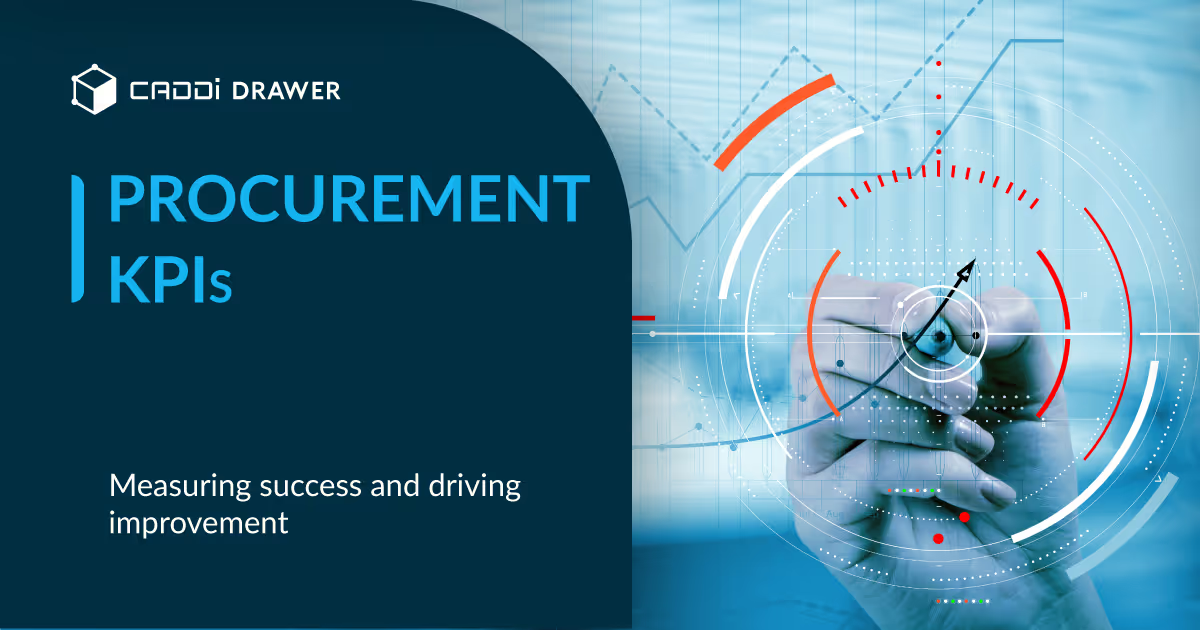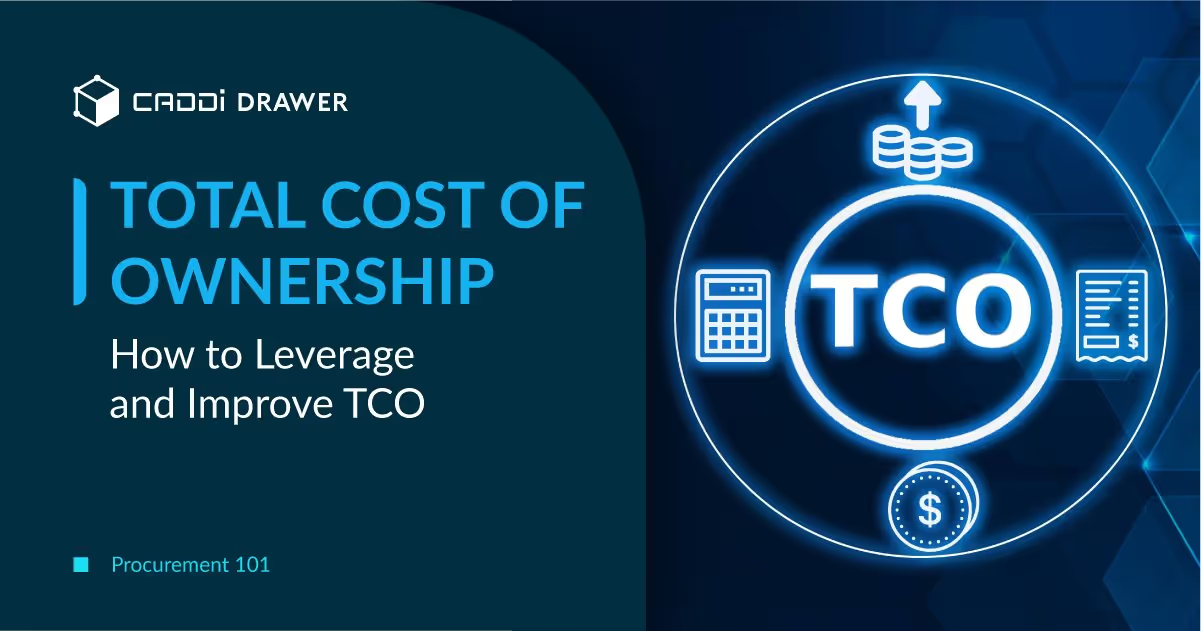Procurement KPIs: Measuring success and driving improvement

Table of Contents

Introduction
Procurement KPIs are metrics used to measure and track the performance of an organization’s procurement activities. Having clear procurement KPIs is essential for driving continuous improvement, maximizing value for money, and aligning procurement with wider business objectives.
Measuring procurement performance provides visibility into how well the function is operating. This enables areas of strength to be recognized and any problems or bottlenecks to be identified. Tracking KPIs over time shows whether implemented changes are having the desired impact. Without measurement, it is impossible to manage performance effectively.
KPIs motivate procurement teams by providing targets to work towards. They facilitate benchmarking to understand performance compared to competitors. Introducing procurement KPIs is a key step in transforming procurement from a back-office function into a strategic driver of value.
Common Procurement KPIs
Procurement departments in the manufacturing industry should track a variety of KPIs to measure performance, identify areas for improvement, and ensure alignment with business objectives. Key procurement KPIs include:
Cost Savings
- Cost Reduction Ratio: Percentage of cost reduction compared to previous spend
- Procurement-Driven Savings: Savings generated through contract negotiations, product substitutions, improved processes etc.
- Material Price Variance: Measures the difference between actual and budgeted prices for materials
Supplier Performance
- On-time Delivery Percentage: Tracks the percentage of orders delivered on time by suppliers
- Supplier Lead Time: Time between placing an order and receiving goods, helps identify potential bottlenecks
- Supplier Defect Rate: Percentage of defective parts or materials received from suppliers
- Supplier Scorecards and Rankings: Comprehensive evaluations of supplier performance
Inventory Management
- Inventory Turnover Ratio: Measures how efficiently a company uses its inventory, with a high ratio indicating quick sales and reduced holding costs
Cycle Time
- Procurement Cycle Time: Total time from identifying a requirement to PO creation
- Length of Sourcing Processes: Tracks the time taken for sourcing activities like RFPs and negotiations
- Invoice Processing Time: Measures the efficiency of invoice handling and payment processes
Spend Management
- Percentage of Addressable Spend Under Contract: Tracks the portion of spend managed through contracts
- Off-contract Spending: Identifies maverick spend outside of established contracts
- Emergency Purchases: Tracks the number and cost of unplanned, rush purchases
Compliance and Accuracy
- Purchase Order Accuracy: Measures the percentage of POs within target prices and with correct quantities and specs
- Contract Compliance: Tracks the percentage of purchases compliant with negotiated contracts
Risk Management
- Supplier Diversification: Monitors the number and mix of suppliers to mitigate supply risk
Regularly monitoring these KPIs provides procurement teams with the insights needed to optimize spend, improve supplier relationships, streamline processes, and demonstrate their value to the organization.
Utilizing KPIs in Practice
Procurement professionals use KPIs daily to track performance, identify issues, and drive continuous improvement.
Here are some specific examples of KPIs in action:
Driving Cost Reduction through Savings and Price Variance Analysis
A category manager reviews Procurement-Driven Savings across her spend categories each month. She identifies that savings are below target for a key direct material. Drilling down, she sees that Material Price Variance is high, indicating that actual prices are exceeding budgeted prices.
She launches an initiative to renegotiate pricing with incumbent suppliers and qualify new suppliers to drive cost reduction.
Ensuring Supply Continuity with On-time Delivery and Lead Time Monitoring
A plant buyer monitors On-time Delivery Percentage weekly. He notices that on-time rates are slipping for a critical component, threatening to disrupt production. He pulls supplier performance data and sees that late deliveries are concentrated with one supplier. A review of Supplier Lead Time data shows the supplier’s lead times are longer than industry benchmarks.
The buyer escalates the issue to management and works with the supplier to compress lead times through improved forecasting and a consignment inventory arrangement.
Strategic Sourcing through Spend Coverage and Off-contract Spend Analysis
A procurement analyst conducts a quarterly review of Percentage of Addressable Spend Under Contract. She segments the data by category and identifies that marketing spend has a low percentage of coverage compared to other categories. Comparing this data to the Off-contract Spending KPI confirms that there is significant maverick spend.
The analyst recommends implementing a strategic sourcing initiative to consolidate marketing agencies and establish formal contracts.
Resolving Quality Issues by Tracking Supplier Defect Rates
A supplier quality engineer tracks Supplier Defect Rates monthly. She identifies that defect rates have increased for a key electronics component, leading to production delays and rework. Analyzing the data, she pinpoints that the issue is isolated to one manufacturing site of a multi-site supplier.
She initiates a supplier corrective action request and works with the supplier to identify and address root causes through process improvements and increased inspections.
Streamlining Processes by Reviewing Cycle Time and Sourcing Duration
A procurement director conducts a semi-annual review of Procurement Cycle Time. He segments the data by commodity type and sees that cycle times are significantly longer for capital equipment purchases compared to other categories. Drilling down into the Length of Sourcing Processes KPI, he identifies that the RFP process is taking longer than benchmarks.
He launches a process improvement initiative to streamline RFP templates, automate bid analysis, and train the team on best practices.
Driving Performance Improvement
Regular tracking of procurement KPIs provides the data needed to identify areas for improvement. However, data alone is not enough – organizations must take action to address underperformance and continuously improve. Here are some best practices for driving procurement performance:
- Automate data collection where possible through procurement software and analytics tools. This provides real-time data and frees up time for analysis.
- Regularly review and analyze KPIs across the procurement organization – by category, supplier, region etc. Look for trends and outliers that indicate opportunities.
- Address underperformance by investigating root causes and implementing corrective actions, such as additional supplier negotiations, process improvements, training, policy changes etc.
- Set stretch targets that encourage procurement teams to innovate and improve. Celebrate wins and improvements.
- Foster a culture of continuous improvement by communicating KPIs openly, providing feedback and coaching, and incentivizing strong performance.
- Learn from high performers within the organization and benchmark against external leaders. Share and replicate success strategies across the organization.
- Review targets regularly as performance improves to prevent complacency. Continually raise the bar on performance expectations.
Combining Metrics for Powerful Insights
While each procurement KPI provides valuable information on its own, the real power comes from combining metrics to generate deeper insights. Here are a couple examples:
Combining Spend and Supplier Performance Metrics for Spend Optimization
Procurement teams can drive significant cost savings by combining spend management and supplier performance KPIs. For example:
- Analyze the Percentage of Addressable Spend Under Contract alongside Procurement-Driven Savings. Identify categories or suppliers with low contract coverage and high savings potential.
- For these opportunities, drill down into Supplier Scorecards and Rankings to assess if consolidating spend with fewer, high-performing suppliers could drive better terms.
- Also review Material Price Variance to spot where actual prices are exceeding targets. Negotiate with incumbent suppliers or explore alternate sources.
- Model scenarios to project the cost reduction impact of moving more spend to contracts with top-performing suppliers. Set targets and pursue strategic sourcing initiatives to realize the savings.
By combining spend, savings and supplier performance metrics in this way, procurement teams can precisely target the most promising opportunities to reduce costs and optimize the supply base.
Improving On-Time Delivery through Segmented Analysis
On-time Delivery Percentage is a critical KPI for ensuring material availability and keeping production lines running. To drive improvement, procurement teams can segment this metric for deeper insights:
- Break down On-time Delivery Percentage by supplier, category, region, and criticality. Identify underperforming segments that are dragging down overall performance.
- For problem categories, analyze Supplier Scorecards and Rankings alongside On-time Delivery rates. Determine if issues are supplier-specific or systemic to the category.
- Review Supplier Lead Time data to pinpoint where lengthy lead times may be contributing to late deliveries. Work with suppliers to compress lead times through process improvements, better forecasting, consignment inventories, etc.
- Examine causes of late deliveries – capacity constraints, quality issues, transportation problems, etc. Address root causes with suppliers through performance improvement plans.
- Set On-time Delivery targets by segment, considering benchmarks and business needs. Monitor progress and escalate issues promptly.
By segmenting On-time Delivery data and combining it with other relevant KPIs, procurement teams can identify specific problem areas, diagnose root causes, and take targeted actions to boost performance.
Conclusion
Procurement KPIs are essential for driving performance improvement and demonstrating the value that procurement delivers to the business. By tracking a balanced set of KPIs, regularly analyzing the data, and taking targeted actions, procurement teams can optimize spend, improve supplier performance, mitigate risk, and streamline processes.
The most effective procurement organizations go beyond just measuring KPIs to truly embedding them into their daily operations and decision making. They use KPIs to set strategic priorities, allocate resources, manage supplier relationships, and drive continuous improvement. By harnessing the power of procurement KPIs, these organizations are elevating procurement’s role as a strategic business partner and value creator.
Introduction
Procurement KPIs are metrics used to measure and track the performance of an organization’s procurement activities. Having clear procurement KPIs is essential for driving continuous improvement, maximizing value for money, and aligning procurement with wider business objectives.
Measuring procurement performance provides visibility into how well the function is operating. This enables areas of strength to be recognized and any problems or bottlenecks to be identified. Tracking KPIs over time shows whether implemented changes are having the desired impact. Without measurement, it is impossible to manage performance effectively.
KPIs motivate procurement teams by providing targets to work towards. They facilitate benchmarking to understand performance compared to competitors. Introducing procurement KPIs is a key step in transforming procurement from a back-office function into a strategic driver of value.
Common Procurement KPIs
Procurement departments in the manufacturing industry should track a variety of KPIs to measure performance, identify areas for improvement, and ensure alignment with business objectives. Key procurement KPIs include:
Cost Savings
- Cost Reduction Ratio: Percentage of cost reduction compared to previous spend
- Procurement-Driven Savings: Savings generated through contract negotiations, product substitutions, improved processes etc.
- Material Price Variance: Measures the difference between actual and budgeted prices for materials
Supplier Performance
- On-time Delivery Percentage: Tracks the percentage of orders delivered on time by suppliers
- Supplier Lead Time: Time between placing an order and receiving goods, helps identify potential bottlenecks
- Supplier Defect Rate: Percentage of defective parts or materials received from suppliers
- Supplier Scorecards and Rankings: Comprehensive evaluations of supplier performance
Inventory Management
- Inventory Turnover Ratio: Measures how efficiently a company uses its inventory, with a high ratio indicating quick sales and reduced holding costs
Cycle Time
- Procurement Cycle Time: Total time from identifying a requirement to PO creation
- Length of Sourcing Processes: Tracks the time taken for sourcing activities like RFPs and negotiations
- Invoice Processing Time: Measures the efficiency of invoice handling and payment processes
Spend Management
- Percentage of Addressable Spend Under Contract: Tracks the portion of spend managed through contracts
- Off-contract Spending: Identifies maverick spend outside of established contracts
- Emergency Purchases: Tracks the number and cost of unplanned, rush purchases
Compliance and Accuracy
- Purchase Order Accuracy: Measures the percentage of POs within target prices and with correct quantities and specs
- Contract Compliance: Tracks the percentage of purchases compliant with negotiated contracts
Risk Management
- Supplier Diversification: Monitors the number and mix of suppliers to mitigate supply risk
Regularly monitoring these KPIs provides procurement teams with the insights needed to optimize spend, improve supplier relationships, streamline processes, and demonstrate their value to the organization.
Utilizing KPIs in Practice
Procurement professionals use KPIs daily to track performance, identify issues, and drive continuous improvement.
Here are some specific examples of KPIs in action:
Driving Cost Reduction through Savings and Price Variance Analysis
A category manager reviews Procurement-Driven Savings across her spend categories each month. She identifies that savings are below target for a key direct material. Drilling down, she sees that Material Price Variance is high, indicating that actual prices are exceeding budgeted prices.
She launches an initiative to renegotiate pricing with incumbent suppliers and qualify new suppliers to drive cost reduction.
Ensuring Supply Continuity with On-time Delivery and Lead Time Monitoring
A plant buyer monitors On-time Delivery Percentage weekly. He notices that on-time rates are slipping for a critical component, threatening to disrupt production. He pulls supplier performance data and sees that late deliveries are concentrated with one supplier. A review of Supplier Lead Time data shows the supplier’s lead times are longer than industry benchmarks.
The buyer escalates the issue to management and works with the supplier to compress lead times through improved forecasting and a consignment inventory arrangement.
Strategic Sourcing through Spend Coverage and Off-contract Spend Analysis
A procurement analyst conducts a quarterly review of Percentage of Addressable Spend Under Contract. She segments the data by category and identifies that marketing spend has a low percentage of coverage compared to other categories. Comparing this data to the Off-contract Spending KPI confirms that there is significant maverick spend.
The analyst recommends implementing a strategic sourcing initiative to consolidate marketing agencies and establish formal contracts.
Resolving Quality Issues by Tracking Supplier Defect Rates
A supplier quality engineer tracks Supplier Defect Rates monthly. She identifies that defect rates have increased for a key electronics component, leading to production delays and rework. Analyzing the data, she pinpoints that the issue is isolated to one manufacturing site of a multi-site supplier.
She initiates a supplier corrective action request and works with the supplier to identify and address root causes through process improvements and increased inspections.
Streamlining Processes by Reviewing Cycle Time and Sourcing Duration
A procurement director conducts a semi-annual review of Procurement Cycle Time. He segments the data by commodity type and sees that cycle times are significantly longer for capital equipment purchases compared to other categories. Drilling down into the Length of Sourcing Processes KPI, he identifies that the RFP process is taking longer than benchmarks.
He launches a process improvement initiative to streamline RFP templates, automate bid analysis, and train the team on best practices.
Driving Performance Improvement
Regular tracking of procurement KPIs provides the data needed to identify areas for improvement. However, data alone is not enough – organizations must take action to address underperformance and continuously improve. Here are some best practices for driving procurement performance:
- Automate data collection where possible through procurement software and analytics tools. This provides real-time data and frees up time for analysis.
- Regularly review and analyze KPIs across the procurement organization – by category, supplier, region etc. Look for trends and outliers that indicate opportunities.
- Address underperformance by investigating root causes and implementing corrective actions, such as additional supplier negotiations, process improvements, training, policy changes etc.
- Set stretch targets that encourage procurement teams to innovate and improve. Celebrate wins and improvements.
- Foster a culture of continuous improvement by communicating KPIs openly, providing feedback and coaching, and incentivizing strong performance.
- Learn from high performers within the organization and benchmark against external leaders. Share and replicate success strategies across the organization.
- Review targets regularly as performance improves to prevent complacency. Continually raise the bar on performance expectations.
Combining Metrics for Powerful Insights
While each procurement KPI provides valuable information on its own, the real power comes from combining metrics to generate deeper insights. Here are a couple examples:
Combining Spend and Supplier Performance Metrics for Spend Optimization
Procurement teams can drive significant cost savings by combining spend management and supplier performance KPIs. For example:
- Analyze the Percentage of Addressable Spend Under Contract alongside Procurement-Driven Savings. Identify categories or suppliers with low contract coverage and high savings potential.
- For these opportunities, drill down into Supplier Scorecards and Rankings to assess if consolidating spend with fewer, high-performing suppliers could drive better terms.
- Also review Material Price Variance to spot where actual prices are exceeding targets. Negotiate with incumbent suppliers or explore alternate sources.
- Model scenarios to project the cost reduction impact of moving more spend to contracts with top-performing suppliers. Set targets and pursue strategic sourcing initiatives to realize the savings.
By combining spend, savings and supplier performance metrics in this way, procurement teams can precisely target the most promising opportunities to reduce costs and optimize the supply base.
Improving On-Time Delivery through Segmented Analysis
On-time Delivery Percentage is a critical KPI for ensuring material availability and keeping production lines running. To drive improvement, procurement teams can segment this metric for deeper insights:
- Break down On-time Delivery Percentage by supplier, category, region, and criticality. Identify underperforming segments that are dragging down overall performance.
- For problem categories, analyze Supplier Scorecards and Rankings alongside On-time Delivery rates. Determine if issues are supplier-specific or systemic to the category.
- Review Supplier Lead Time data to pinpoint where lengthy lead times may be contributing to late deliveries. Work with suppliers to compress lead times through process improvements, better forecasting, consignment inventories, etc.
- Examine causes of late deliveries – capacity constraints, quality issues, transportation problems, etc. Address root causes with suppliers through performance improvement plans.
- Set On-time Delivery targets by segment, considering benchmarks and business needs. Monitor progress and escalate issues promptly.
By segmenting On-time Delivery data and combining it with other relevant KPIs, procurement teams can identify specific problem areas, diagnose root causes, and take targeted actions to boost performance.
Conclusion
Procurement KPIs are essential for driving performance improvement and demonstrating the value that procurement delivers to the business. By tracking a balanced set of KPIs, regularly analyzing the data, and taking targeted actions, procurement teams can optimize spend, improve supplier performance, mitigate risk, and streamline processes.
The most effective procurement organizations go beyond just measuring KPIs to truly embedding them into their daily operations and decision making. They use KPIs to set strategic priorities, allocate resources, manage supplier relationships, and drive continuous improvement. By harnessing the power of procurement KPIs, these organizations are elevating procurement’s role as a strategic business partner and value creator.
Ready to see CADDi Drawer in action? Get a personalized demo.
Subscribe to our Blog!
Related Resources












.svg)



.svg)
.svg)
.svg)


